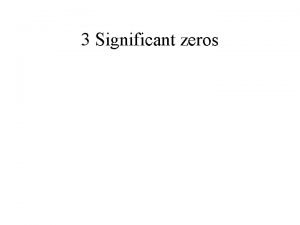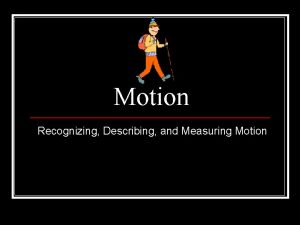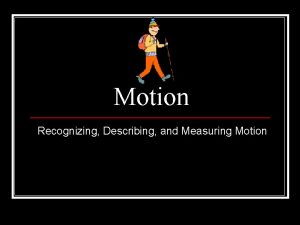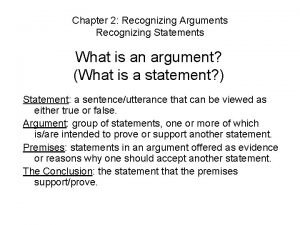MOTION NOTES Recognizing Motion How can you tell













- Slides: 13

MOTION NOTES

Recognizing Motion How can you tell if an object is moving? • Reference Point: • a place or object used for comparison to determine if something is in motion. An object is in motion if it changes position relative to a reference point.

Recognizing Motion • Your PERCEPTION of “motion” depends on your REFERENCE POINT. • Ex) Imagine you are sitting in a seat on the train pictured here… • From the perspective of someone standing outside on the platform, are you moving? • What about from the perspective of passenger seated next to you? • These questions could have different answers! another

Speed The distance an object travels in a certain time • speed = distance = _d_ time t units = (m/s) or (km/hr) d s t • Cover the variable you’re solving for. The two remaining variables show you whether to multiply or divide!

Practice Problems: Speed 1) At what speed is a plane flying if it travels 1760 meters in 8 seconds? s = d/t s = 1760 m / 8 s s = 220 m/s

More Examples: 2) A car travels 240 kilometers in 3 hours. What is the speed of the car during that time? s = d/t = (240 km)/(3 hr) = 80 km/hr 3) The speed of a cruise ship is 50 km/hr. How far will the ship travel in 14 hours? d = st = (50 km/hr)(14 hr) = 700 km 4) A cyclist travels 32 km during the first 2 hours of riding, and 13 km during the next hour. What is the average speed of the cyclist? s = d/t = (32 km + 13 km)/(2 hr + 1 hr) = 15 km/hr

Velocity • speed in a given direction. velocity = displacement = _d_ time t • “Displacement” is the distance between the starting point and ending point (different from “distance”) • Note that the velocity equation is VERY similar to the speed equation d v t • NOTE: calculated just like speed (same units too)!

Scalars and Vectors • Scalar quantities have a magnitude (number, size) without a specified direction. • Vector quantities have both magnitude AND direction. • Speed is a scalar, velocity is a vector. 5 m/s East • IMPORTANT: sometimes in physics, we designate direction as “+” (forward, up) or “–” (backward, down)

Acceleration • A change in velocity over a certain amount of time. • increasing speed, decreasing speed, or changing direction • acceleration = final velocity - initial velocity time • a = ∆v ∆ = change in… t Units: m/s 2 ∆v a t

Practice Problems: Acceleration 5) A car is traveling at 6 m/s. It accelerates to 16 m/s in 5 seconds. What is the acceleration of the car? a = ∆v/t = (16 m/s – 6 m/s)/5 s = 2 m/s 2 6) A roller coaster is moving at 25 m/s at the bottom of a hill. Three seconds later it reaches the top of the next hill, moving at 10 m/s. What is the acceleration of the roller coaster? a = ∆v/t = (10 m/s – 25 m/s)/3 s = -5 m/s 2 IMPORTANT: The negative sign indicates the object is slowing down!

Graphing Motion • distance vs. time graph • displacement on the y-axis • time on the x-axis • The slope tells you the speed. • SLOPE = “steepness” of the line • slope = rise = y 2 -y 1 run x 2 -x 1 • In this graph, you can tell that swimmer 1 is faster because the motion of swimmer 1 produces a steeper slope (steeper slope = faster) • You can calculate swimmer 1’s speed by calculating the slope: slope = (y 2 -y 1)/(x 2 -x 1) = (100 -0 m)/(50 -0 s) = 2 m/s

Graphing Motion 7) Constant Forward Displacement vs Time Motion 8) Constant Backward Motion 9) Speeding Up d 10) Slowing Down 11) Changing Direction 12) No Motion t

Practice Problems: Motion 13) Plane A is flying East at 880 km/hr and plane B is traveling North at 880 km/hr. Do they have the same speed? The same velocity? Explain. Plane A and B have the same speed (880 km/hr) but different velocities because they’re travelling in different directions. 14) A swimmer speeds up from 1. 1 m/s to 1. 3 m/s during the last 20 seconds of her workout. What is her acceleration during this interval? a = ∆v/t = (1. 3 - 1. 1 m/s)/20 s = 0. 01 m/s 2 15) Which is going faster, a boy who runs 40 m in 8 s or a girl who runs 55 m in 10 s? Boy: s = d/t = 40 m/8 s = 5 m/s Girl: s = d/t = 55 m/10 s = 5. 5 m/s
 Tell me what you eat and i shall tell you what you are
Tell me what you eat and i shall tell you what you are Kinds of comparison
Kinds of comparison You can tell harris about it just ____(easily) as i can.
You can tell harris about it just ____(easily) as i can. How to be more impressive 1+1=2
How to be more impressive 1+1=2 If you think you can you can poem
If you think you can you can poem If you can imagine it you can achieve it
If you can imagine it you can achieve it You cannot improve what you cannot measure explain
You cannot improve what you cannot measure explain If you cant measure it you can't manage it
If you cant measure it you can't manage it You can t manage what you don t measure
You can t manage what you don t measure You can't manage what you can't measure bedeutung
You can't manage what you can't measure bedeutung Can you please tell me
Can you please tell me Tell us about a film you really like
Tell us about a film you really like How can you tell whether zeros are significant
How can you tell whether zeros are significant Could you tell me? where is the bookstore?
Could you tell me? where is the bookstore?

























